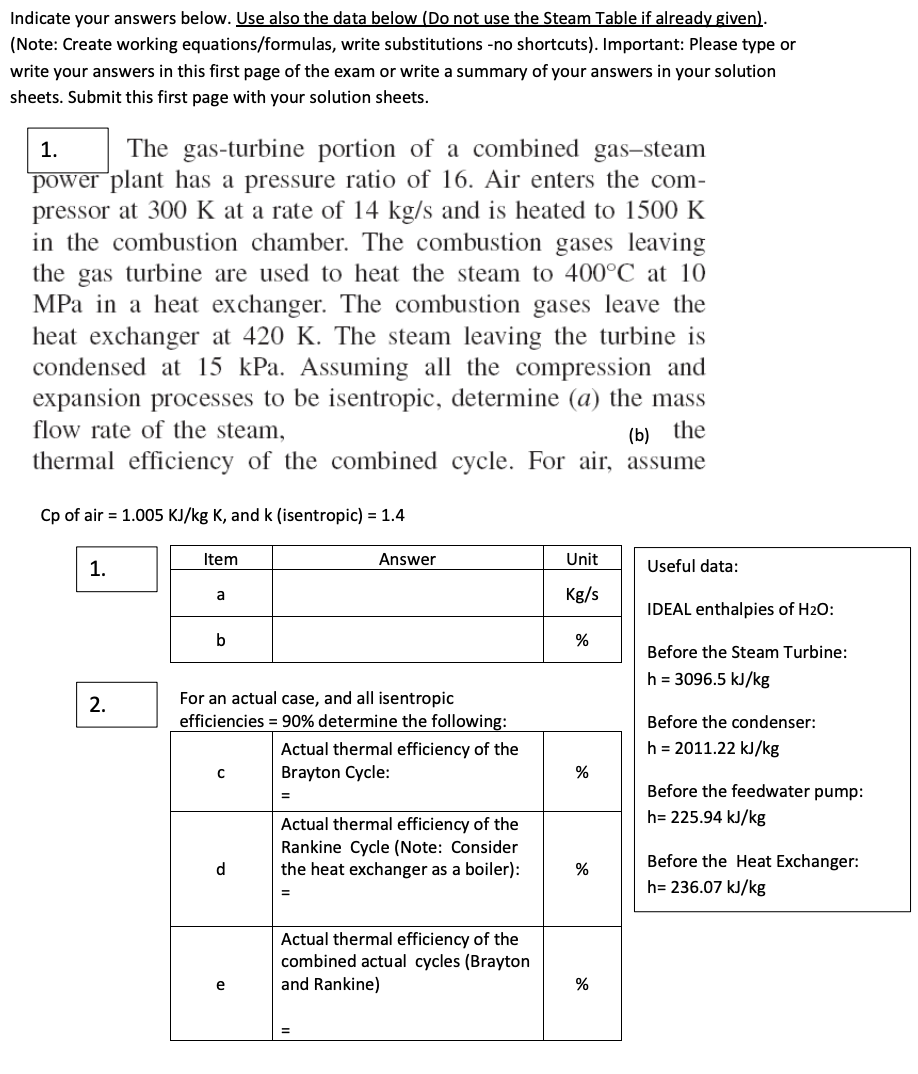1. The gas-turbine portion of a combined gas-steam power plant has a pressure ratio of 16. Air enters the com- pressor at 300 K at a rate of 14 kg/s and is heated to 1500 K in the combustion chamber. The combustion gases leaving the gas turbine are used to heat the steam to 400°C at 10 MPa in a heat exchanger. The combustion gases leave the heat exchanger at 420 K. The steam leaving the turbine is condensed at 15 kPa. Assuming all the compression and expansion processes to be isentropic, determine (a) the mass flow rate of the steam, (b) the thermal efficiency of the combined cycle. For air, assume Cp of air = 1.005 KJ/kg K, and k (isentropic) = 1.4
1. The gas-turbine portion of a combined gas-steam power plant has a pressure ratio of 16. Air enters the com- pressor at 300 K at a rate of 14 kg/s and is heated to 1500 K in the combustion chamber. The combustion gases leaving the gas turbine are used to heat the steam to 400°C at 10 MPa in a heat exchanger. The combustion gases leave the heat exchanger at 420 K. The steam leaving the turbine is condensed at 15 kPa. Assuming all the compression and expansion processes to be isentropic, determine (a) the mass flow rate of the steam, (b) the thermal efficiency of the combined cycle. For air, assume Cp of air = 1.005 KJ/kg K, and k (isentropic) = 1.4
Elements Of Electromagnetics
7th Edition
ISBN:9780190698614
Author:Sadiku, Matthew N. O.
Publisher:Sadiku, Matthew N. O.
ChapterMA: Math Assessment
Section: Chapter Questions
Problem 1.1MA
Related questions
Question

Transcribed Image Text:Indicate your answers below. Use also the data below (Do not use the Steam Table if already given).
(Note: Create working equations/formulas, write substitutions -no shortcuts). Important: Please type or
write your answers in this first page of the exam or write a summary of your answers in your solution
sheets. Submit this first page with your solution sheets.
1.
The gas-turbine portion of a combined gas–steam
power plant has a pressure ratio of 16. Air enters the com-
pressor at 300 K at a rate of 14 kg/s and is heated to 1500 K
in the combustion chamber. The combustion gases leaving
the gas turbine are used to heat the steam to 400°C at 10
MPa in a heat exchanger. The combustion gases leave the
heat exchanger at 420 K. The steam leaving the turbine is
condensed at 15 kPa. Assuming all the compression and
expansion processes to be isentropic, determine (a) the mass
flow rate of the steam,
(b) the
thermal efficiency of the combined cycle. For air, assume
Cp of air = 1.005 KJ/kg K, and k (isentropic) = 1.4
Item
Answer
Unit
1.
Useful data:
a
Kg/s
IDEAL enthalpies of H2O:
b
%
Before the Steam Turbine:
h = 3096.5 kJ/kg
For an actual case, and all isentropic
efficiencies = 90% determine the following:
2.
Before the condenser:
h = 2011.22 kJ/kg
Actual thermal efficiency of the
Brayton Cycle:
%
Before the feedwater pump:
h= 225.94 kJ/kg
Actual thermal efficiency of the
Rankine Cycle (Note: Consider
the heat exchanger as a boiler):
Before the Heat Exchanger:
d
%
h= 236.07 kJ/kg
Actual thermal efficiency of the
combined actual cycles (Brayton
e
and Rankine)
%
Expert Solution
This question has been solved!
Explore an expertly crafted, step-by-step solution for a thorough understanding of key concepts.
Step by step
Solved in 3 steps with 1 images

Knowledge Booster
Learn more about
Need a deep-dive on the concept behind this application? Look no further. Learn more about this topic, mechanical-engineering and related others by exploring similar questions and additional content below.Recommended textbooks for you

Elements Of Electromagnetics
Mechanical Engineering
ISBN:
9780190698614
Author:
Sadiku, Matthew N. O.
Publisher:
Oxford University Press

Mechanics of Materials (10th Edition)
Mechanical Engineering
ISBN:
9780134319650
Author:
Russell C. Hibbeler
Publisher:
PEARSON

Thermodynamics: An Engineering Approach
Mechanical Engineering
ISBN:
9781259822674
Author:
Yunus A. Cengel Dr., Michael A. Boles
Publisher:
McGraw-Hill Education

Elements Of Electromagnetics
Mechanical Engineering
ISBN:
9780190698614
Author:
Sadiku, Matthew N. O.
Publisher:
Oxford University Press

Mechanics of Materials (10th Edition)
Mechanical Engineering
ISBN:
9780134319650
Author:
Russell C. Hibbeler
Publisher:
PEARSON

Thermodynamics: An Engineering Approach
Mechanical Engineering
ISBN:
9781259822674
Author:
Yunus A. Cengel Dr., Michael A. Boles
Publisher:
McGraw-Hill Education

Control Systems Engineering
Mechanical Engineering
ISBN:
9781118170519
Author:
Norman S. Nise
Publisher:
WILEY

Mechanics of Materials (MindTap Course List)
Mechanical Engineering
ISBN:
9781337093347
Author:
Barry J. Goodno, James M. Gere
Publisher:
Cengage Learning

Engineering Mechanics: Statics
Mechanical Engineering
ISBN:
9781118807330
Author:
James L. Meriam, L. G. Kraige, J. N. Bolton
Publisher:
WILEY